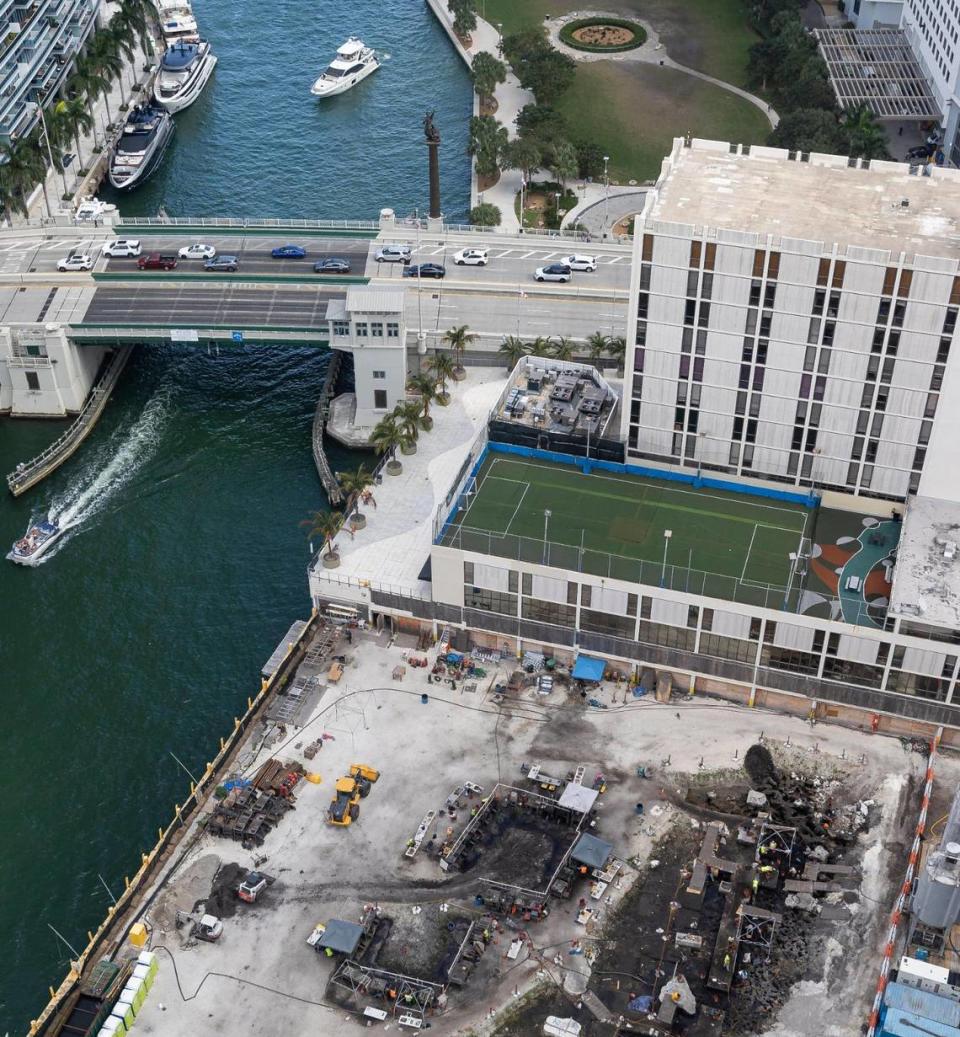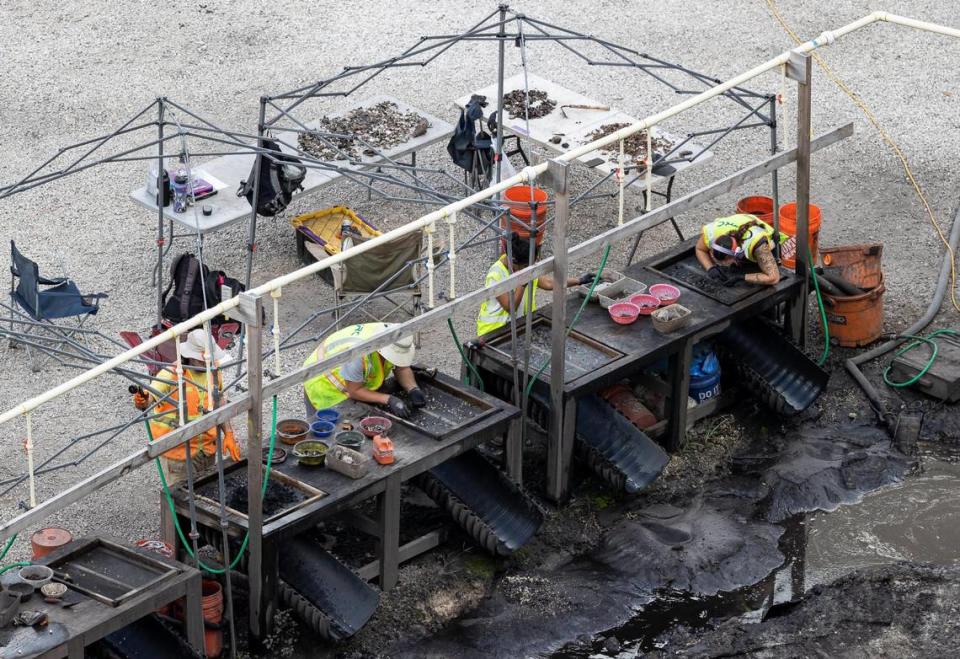City leaders recommend preserving Miami River site, after discovery of ancient artifacts
A big piece of the recently uncovered prehistoric indigenous settlement near the mouth of the Miami River appears on its way to securing legal protection from the city as an archaeological site — but it still remains unclear to what extent remnants of the ancient find will be preserved or exhibited publicly in the long term.
On Tuesday, Miami’s historic preservation board will consider a report by the city archaeologist that concludes the property at 444 Brickell Avenue — an as-yet unexcavated portion of the extensive lot — meets the legal criteria for designation as an archaeological site because it’s likely to contain significant materials thousands of years old.
If the board which ordered the report agrees, it would set in motion a legal process that would give the city significant legal sway over development and the treatment of archaeological elements on the lot, one piece of a larger plot of land under redevelopment by The Related Group.
Related started construction earlier this year on one of two previously approved residential towers that will occupy an abutting vacant property. Archaeologists have finished excavating that half of the vacant land, but digging continues on the other portion at the river’s edge, where Related plans to build a luxury condo tower called Baccarat Residences.
In theory, the board could eventually try to block residential development on the 444 Brickell property, but that’s high improbable. Related intends to eventually demolish an office building occupying the lot.
A more likely result would be a requirement that Related preserve and provide public access to at least some of the site’s finds, which include hundreds of thousands of artifacts, pottery shards and other materials, as well as patterns of postholes in the limestone that archaeologists say formed the foundation of structures of a 2,500-year-old Tequesta Indian village.
Some spear points found at the site date back even longer, some 7,000 years or so, to the Late Archaic period of prehistory, suggesting the possibility it has been continuously occupied since then, independent archaeologists say.

The assumption underlying city archaeologist Adrian Espinosa-Valdor’s report is that excavation under 444 Brickell, current site of a 13-story, 1972 building housing offices and the Capital Grille restaurant, will yield similar findings once the building is torn down.
Photos in the report show that an expansive ancient midden — a deposit of artifacts and prehistoric refuse — in the limestone bedrock at the abutting vacant, excavated portion of the Related property clearly extends into and below the modern foundations of 444 Brickell, which covers more than 1.5 acres of land.
Archaeologists have concluded the overall Related site represents only a portion of a far larger Tequesta town that at its peak extended to both banks of the river and included what’s now the Miami Circle National Historic Landmark, on the other side of present-day Brickell Avenue from 444 Brickell.
The Miami Circle, which consists of postholes arranged in a round shape at the point where the south bank of the river meets Biscayne Bay, is believed to have served as the foundation for a large ceremonial structure.
“Although no archaeological excavations have been conducted to precisely understand the cultural resources beneath 444 Brickell Avenue, excavations at the adjacent 77 SE 5 Street parcel managed to expose midden beneath the subject parcel parking garage,” Espinosa-Valdor wrote. “Therefore, [the archaeological site] continues beneath 444 Brickell, but to a yet unknown extent.”
Tuesday’s hearing comes three months after a heated public meeting at which Related officials dropped objections to a proposal for historic designation of 444 Brickell drawn up by city preservation officials and a group of independent archaeologists. Related relented after the board agreed not to pursue protection for the rest of the developer’s abutting riverfront property.
Related also promised to prepare a plan for how it would provide public access to at least a portion of the archaeological finds on the site, although such a document has not been released.
Several board members said in April that their aim was to set the table for a legally enforceable agreement with Related that could entail preservation of some portions of the site, ensure public exhibit of archaeological discoveries and help fund research into them.

In a statement released through a spokesperson on Monday, Related said it remains on board with the agreement. Its plan for handling the site’s archaeological features won’t be released until after the ongoing digging on the vacant portion of the property is completed, Related said.
“The Related Group continues to collaborate with the City of Miami on the designation of the 444 Brickell Avenue property,” according to the developer’s statement. “The archaeological excavation and assessment of the findings at the 77 S.E. Fifth Street site is still in process. After the assessment is concluded, the action plan for the preservation of the archaeological findings at the site will be presented.”
In the short term, a “yes” vote on preliminary designation by the preservation board on Tuesday would impose a temporary moratorium on development on the property while the city’s preservation office prepares an in-depth report on the merits of enacting permanent protection.
The area excavated so far, formerly the site of a demolished U.S. Customs building and parking garage, has yielded thousands of artifacts and remnants of Native American settlement on the site going back thousands of years, including some human remains. (Under Florida law, they are reburied at an undisclosed location under the supervision of Native American tribal members).
Although archaeologists have long known the Related site likely contained some ancient remnants of Tequesta life on the river, the site never had been excavated. The richness, age and well-preserved state of the discoveries have surprised and excited experts who say it opens up new windows into the history of indigenous settlement in what would later become Miami.
Because the development site is located in a city-designated archaeological zone, Related was legally obligated to conduct excavations, which firm chairman and founder Jorge Perez earlier this year said had cost the company $20 million. Those excavations have have been overseen for Related by the Archaeological and Historical Conservancy, led by veteran South Florida archaeologist Bob Carr.

